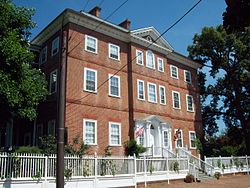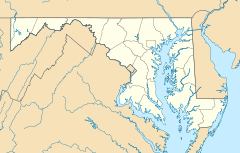- Chase-Lloyd House
-
Chase-Lloyd HouseChase-Lloyd House, July 2009
Location: 22 Maryland Avenue, Annapolis, Maryland Coordinates: 38°58′52″N 76°29′21″W / 38.98111°N 76.48917°WCoordinates: 38°58′52″N 76°29′21″W / 38.98111°N 76.48917°W Built: 1769 Architect: Buckland,William and Noke, William Architectural style: Georgian Governing body: Private NRHP Reference#: 70000260 Significant dates Added to NRHP: April 15, 1970[1] Designated NHL: April 15, 1970[2] The Chase-Lloyd House in Annapolis, Maryland is a brick three-story Georgian mansion dating from 1769-1774 with interiors by William Buckland [3]. Its construction was started for Samuel Chase, who would later be a signatory to the Declaration of Independence and Associate Justice of the Supreme Court, but Chase sold the building unfinished to Edward Lloyd IV in 1771. Lloyd completed the house in 1774 with assistance from Buckland and another architect, William Noke. The house remained in the Lloyd family until 1847, when it was sold back to descendants of Chase. In 1888 the house was bequeathed for use as a home for elderly women. It continues in this use today [4]. While the upper floors are off limits to visitors, the main floor and the extensive gardens are open to the public.
Contents
Description
The three story brick house stands over a tall basement and measures 54 feet (16 m) wide and 43 feet (13 m) deep. The 18 inches (46 cm) thick walls are laid in Flemish bond with belt courses of rubbed brick at the second and third floor lines. The front is accented by a central three-bay wide projecting pavilion. The three-part central door with pediment, entablature, fanlight and sidelights is unusual for pre-Revolutionary times. Above the door a triple window on the second floor is followed by an arched window on the third floor. Windows are capped by flat arches of rubbed brick. First and second floor windows are six-over-six, while third floor windows are six-over-three. The rear pavilion features a large Palladian window that relates to the main stair landing on the interior.[5]
The house's plan is of the four room, center hall type, but on a very large scale. The entrance hall contains a screen of free-standing Ionic order Ionic columns, beyond which a central stair rises to the large Palladian window at the landing. The ascending stair flights split at the landing, rising in parallel runs to flank the first run on either side. The flights were originally unsupported, but supports have since been inserted to correct sagging.[5]
Interior ceilings feature plaster moldings in the manner of Robert Adam. The woodwork, and particularly the door frames of the first floor, is extensively carved. Interior doors are six-panel mahogany with wrought-silver handles. The most elaborate woodwork is in the dining room; this room has, however, lost its original plaster ceiling. On the second floor the bedrooms are accessed through arched openings with panels in the reveals. The house's original kitchen was located in the basement.[5]
A separate structure to the rear, called the Chase Annex, is a 19th-century addition.[5]
The house was designated a National Historic Landmark in 1970 [1].
See also
- Wye House: National Historic Landmark in Talbot County, Maryland, built for Edward Lloyd IV in 1790.
- Hammond-Harwood House, another National Historic Landmark, located across the street
- Colonial families of Maryland
Gallery
References
- ^ a b "National Register Information System". National Register of Historic Places. National Park Service. 2009-03-13. http://nrhp.focus.nps.gov/natreg/docs/All_Data.html.
- ^ "Chase-Lloyd House". National Historic Landmark summary listing. National Park Service. http://tps.cr.nps.gov/nhl/detail.cfm?ResourceId=932&ResourceType=Building. Retrieved 2008-06-16.
- ^ "Maryland Historical Trust". National Register of Historic Places: Properties in Anne Arundel County. Maryland Historical Trust. 2008-06-08. http://www.mht.maryland.gov/nr/NRDetail.aspx?HDID=35&FROM=NRNHLList.aspx.
- ^ "Survey of Historic Sites and Properties". Signers of the Declaration of Independence. National Park Service. 2008-06-11. http://www.nps.gov/history/history/online_books/declaration/site13.htm.
- ^ a b c d Heintzelman, Patricia; Snell, Charles (July 30, 1974). "National Register of Historic Places Nomination: Chase-Lloyd House". National Park Service. http://pdfhost.focus.nps.gov/docs/NHLS/Text/70000260.pdf. Retrieved 2009-03-18.
External links
- Chase-Lloyd House, Anne Arundel County, including photo c. 1972, at Maryland Historical Trust
- Chase-Lloyd House, 22 Maryland Avenue & King George Street, Annapolis, Anne Arundel County, MD: 3 photos, 3 data pages, 7 drawings, at Historic American Building Survey
- National Park Service information on Chase-Lloyd House
U.S. National Register of Historic Places Topics Lists by states Alabama • Alaska • Arizona • Arkansas • California • Colorado • Connecticut • Delaware • Florida • Georgia • Hawaii • Idaho • Illinois • Indiana • Iowa • Kansas • Kentucky • Louisiana • Maine • Maryland • Massachusetts • Michigan • Minnesota • Mississippi • Missouri • Montana • Nebraska • Nevada • New Hampshire • New Jersey • New Mexico • New York • North Carolina • North Dakota • Ohio • Oklahoma • Oregon • Pennsylvania • Rhode Island • South Carolina • South Dakota • Tennessee • Texas • Utah • Vermont • Virginia • Washington • West Virginia • Wisconsin • WyomingLists by territories Lists by associated states Other Categories:- Houses in Annapolis, Maryland
- Houses on the National Register of Historic Places in Maryland
- 1769 architecture
- National Historic Landmarks in Maryland
Wikimedia Foundation. 2010.




